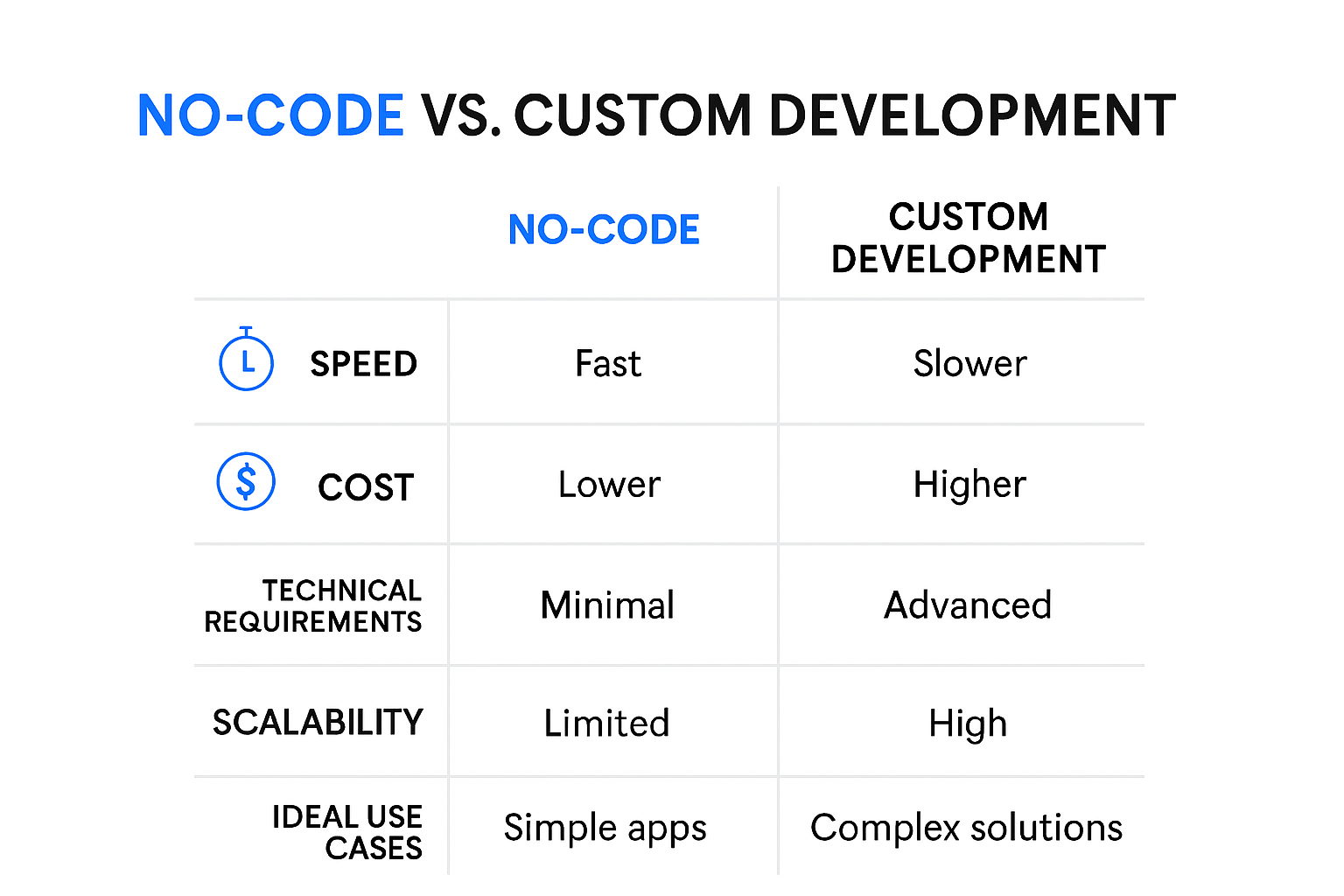Choosing Between No-Code and Custom: Guide for Businesses 2025
Choosing the right way to build digital tools can make or break a business in 2025. Here is something you might not expect. No-code platforms can cut development time from one to two years down to just three to six weeks . Most people assume tech innovation is all about custom coding, but it turns out the fastest moves in business may come from those who skip the code altogether.
Table of Contents
- Understanding No-Code And Custom Development
- Key Factors When Choosing The Right Approach
- Cost, Speed, And Scalability In 2025
- Real-World Examples For Business Decision Makers
Quick Summary
| Takeaway | Explanation |
|---|---|
| No-Code vs. Custom Development | Businesses must evaluate their needs, costs, and long-term goals to choose between no-code platforms, which offer speed and accessibility, and custom development, which provides advanced functionality and flexibility. |
| Importance of Scalability | Future scalability is crucial; while no-code solutions excel in rapid deployment, custom development provides the robust architecture needed for ongoing growth and complex integration. |
| Cost-Effectiveness of No-Code | No-code platforms allow rapid application development with lower upfront costs and reduced dependency on specialized talent, making them attractive for startups and SMEs looking to innovate without substantial financial risk. |
| Strategic Hybrid Approach | The most effective strategy may involve a hybrid model that utilizes the strengths of both no-code and custom development, allowing businesses to adapt their technological capabilities over time. |
Understanding No-Code and Custom Development
Choosing between no-code and custom development represents a critical strategic decision for businesses seeking digital transformation. These two approaches offer distinct pathways to creating digital solutions, each with unique characteristics that can significantly impact a company’s technological infrastructure and operational efficiency.

The Evolution of Digital Development
Digital development has transformed dramatically over the past decade. Traditional custom development required extensive programming knowledge and substantial time investments. In contrast, modern approaches like no-code platforms have democratized application creation, enabling professionals without deep technical backgrounds to build functional digital tools.
According to Microsoft’s Digital Transformation Research , no-code platforms enable rapid application development through visual interfaces. These platforms allow users with minimal coding knowledge to create functional applications efficiently, representing a significant shift in technological accessibility.
Comparing Development Approaches
No-code development offers a user-friendly, visual approach to building applications. These platforms provide drag-and-drop interfaces, pre-built templates, and intuitive design tools that simplify the development process. Businesses can quickly prototype and launch digital solutions without extensive programming expertise.
Custom development, by contrast, provides unparalleled flexibility and precision. As SAP’s Technology Insights highlights, custom solutions offer complete control over features, design, and security. This approach becomes crucial for businesses with complex, unique requirements that cannot be easily addressed by standardized platforms.
Here’s a table that visually compares the key features and benefits of No-Code and Custom Development approaches as described in this section:
| Feature/Aspect | No-Code Development | Custom Development |
|---|---|---|
| Ease of Use | User-friendly, visual, drag-and-drop interfaces | Requires programming background |
| Development Speed | Rapid (weeks instead of years) | Slower, extensive planning and coding |
| Customization/Flexibility | Limited, based on platform templates | High, tailored to specific business needs |
| Integration Capabilities | Basic to moderate, standard integrations | Advanced, complex integrations possible |
| Cost | Lower upfront and resource costs | Higher initial investment and maintenance costs |
| Security | Standardized, platform-driven | Customizable, can meet specific regulatory requirements |
| Scalability | Good for standard use; may face growth limits | Designed for long-term, scalable architecture |
Strategic Considerations for Businesses
The choice between no-code and custom development depends on multiple factors. No-code platforms excel in scenarios requiring rapid deployment, cost-effectiveness, and accessibility. They work exceptionally well for standard business processes, internal tools, and straightforward digital applications.
Custom development becomes the preferred option when businesses need:
- Unique Functionality : Highly specialized features not available in standard platforms
- Advanced Integration : Complex connections with existing systems
- Scalability : Long-term solutions designed for extensive growth
- Robust Security : Tailored security protocols matching specific industry standards
According to Microsoft’s Development Insights , while no-code platforms provide speed and accessibility, they may have limitations in customization and scalability. This constraint becomes critical for businesses with intricate technological ecosystems.
Ultimately, selecting between no-code and custom development requires a nuanced understanding of your business’s current needs and future aspirations. Each approach offers distinct advantages, and the most effective strategy often involves a strategic blend of both methodologies.
Key Factors When Choosing the Right Approach
Selecting the optimal development approach requires a comprehensive evaluation of multiple strategic considerations that extend beyond surface-level technical capabilities. Businesses must conduct a thorough analysis of their specific requirements, resources, and long-term digital transformation objectives.
Technical Complexity and Customization Requirements
The level of technical complexity and desired customization significantly influences the decision between no-code and custom development. According to an empirical research study , over 40% of developer discussions about low-code platforms centered on customization challenges, particularly concerning user interfaces and service configurations.
No-code platforms offer remarkable simplicity and rapid deployment but often come with inherent limitations. They excel at creating standard business applications with predefined templates and straightforward workflows. However, when businesses require advanced functionality such as complex integrations, unique algorithmic processes, or highly specialized features, custom development becomes the preferred solution.
Businesses must carefully assess their specific requirements:
- Complex Data Processing : Custom solutions provide granular control over data manipulation
- Unique Business Logic : Specialized workflows that deviate from standard templates
- Performance Optimization : Precise performance tuning and resource management

Economic and Resource Considerations
Economic factors play a crucial role in selecting the appropriate development approach. Entrepreneurial research reveals that many entrepreneurs initially gravitate towards no-code platforms due to significant advantages in cost-effectiveness and reduced technical barriers.
No-code platforms typically offer:
- Lower upfront development costs
- Reduced dependency on specialized technical talent
- Faster time-to-market for initial product versions
Custom development, while potentially more expensive, provides:
- Complete ownership of the technological infrastructure
- Scalable solutions tailored precisely to business needs
- Greater long-term flexibility and adaptability
The following table summarizes the economic and resource considerations for both development approaches as described above:
| Consideration | No-Code Platform Benefits | Custom Development Benefits |
|---|---|---|
| Upfront Development Cost | Lower | Higher |
| Talent Needs | Non-IT staff and less specialized | Specialized developers required |
| Time to Market | Faster (weeks) | Slower (months to years) |
| Infrastructure Requirement | Minimal/cloud-based | Full ownership, possible hardware needed |
| Long-Term Flexibility | Some limitations | High; tailored to evolving needs |
| Ongoing Adaptability | Limited customization | Easily modified and scaled |
Future Scalability and Technological Adaptability
The chosen development approach must align with the organization’s future growth trajectory. A robust solution should not only address current requirements but also provide the flexibility to evolve alongside the business.
According to developer ecosystem research , platforms with limited dynamic event handling capabilities can significantly constrain technological adaptability. Approximately 75.9% of complex event-related questions in low-code environments remain unresolved, highlighting potential scalability challenges.
Key scalability considerations include:
- Integration Capabilities : Ease of connecting with future technologies
- Performance Scaling : Ability to handle increased computational demands
- Architectural Flexibility : Potential for system modifications and expansions
Businesses must conduct a forward-looking assessment that transcends immediate needs. While no-code platforms offer rapid initial development, custom solutions provide the architectural foundation necessary for sustained technological innovation. The most strategic approach often involves a hybrid model that leverages the strengths of both methodologies, allowing organizations to balance speed, cost-effectiveness, and long-term technological adaptability.
Cost, Speed, and Scalability in 2025
As businesses navigate the complex digital transformation landscape in 2025, understanding the intricate dynamics of cost, speed, and scalability becomes paramount. The technological ecosystem demands solutions that not only address immediate operational needs but also provide strategic flexibility for future growth.
Development Speed and Time-to-Market
In an era of rapid technological advancement, development speed has emerged as a critical competitive differentiator. World Economic Forum research reveals that no-code platforms can dramatically compress application development timelines from one to two years down to an astonishing three to six weeks. This acceleration represents a transformative shift in how businesses conceptualize and implement digital solutions.
The implications of accelerated development are profound:
- Rapid Prototyping : Businesses can quickly test and iterate digital concepts
- Reduced Market Entry Barriers : Faster development enables more agile responses to market opportunities
- Decreased Innovation Cycles : Shorter development periods facilitate continuous technological evolution
Economic Implications and Cost Efficiency
Economic considerations remain a pivotal factor in technology adoption strategies. Academic research from arXiv demonstrates that no-code platforms enable non-IT staff to build applications, significantly reducing the dependency on specialized developer talent and lowering overall development costs.
Key economic advantages include:
- Lower Talent Acquisition Costs : Reduced reliance on expensive programming specialists
- Minimal Infrastructure Investment : Cloud-based no-code platforms minimize hardware expenditures
- Faster Return on Investment : Quicker development translates to faster revenue generation
Scalability and Long-Term Performance
While no-code solutions offer remarkable initial advantages, businesses must critically evaluate their long-term scalability potential. Research findings indicate that while these platforms provide rapid development, they may encounter significant challenges as applications grow in complexity and performance requirements.
Scalability considerations for businesses include:
- Performance Limitations : Potential constraints in handling increased computational demands
- Customization Restrictions : Limited flexibility for advanced, specialized functionalities
- Integration Complexity : Challenges in connecting with sophisticated enterprise systems
Businesses in 2025 must adopt a nuanced approach that balances immediate development needs with future technological requirements. While no-code platforms offer unprecedented speed and cost-effectiveness, they should be viewed as part of a broader, adaptive digital strategy. The most successful organizations will likely implement a hybrid model that leverages no-code platforms for rapid prototyping and standard processes while maintaining the capability to transition to custom development for mission-critical, high-performance applications.
Ultimately, the goal is not to choose between no-code and custom development but to create a flexible technological ecosystem that can dynamically respond to evolving business needs. Strategic technology leaders will view these approaches as complementary tools in their digital transformation toolkit, each serving specific purposes at different stages of technological growth.
Real-World Examples for Business Decision Makers
Navigating the complex terrain of digital development requires more than theoretical understanding. Business decision makers need concrete, actionable insights derived from real-world implementations to make informed strategic choices between no-code and custom development approaches.
Startup and Small Business Innovations
Research from software startup ecosystems reveals a compelling trend of leveraging no-code platforms for rapid prototyping and concept validation. Startups are increasingly using these tools to quickly test business ideas with minimal financial risk, dramatically reducing the traditional barriers to technological experimentation.
Consider the journey of emerging businesses:
- Rapid Prototype Development : Creating functional minimum viable products in weeks
- Cost-Effective Market Testing : Validating concepts without substantial upfront investment
- Accelerated Innovation Cycles : Quickly iterating based on user feedback
Enterprise Digital Transformation Strategies
European digital transformation research demonstrates how organizations are strategically adopting no-code platforms to enhance operational agility. These implementations often transform complex business processes in remarkably short timeframes, providing a competitive edge in rapidly evolving market environments.
Enterprise adoption strategies typically encompass:
- Process Automation : Streamlining repetitive administrative tasks
- Internal Tool Development : Creating custom solutions without extensive IT intervention
- Cross-Department Collaboration : Enabling non-technical teams to contribute to digital initiatives
Small and Medium Enterprise Technology Adoption
Research analyzing technology implementation in SMEs highlights the transformative potential of no-code platforms for organizations with limited technical resources. These tools provide an accessible pathway to digital innovation, allowing businesses with constrained budgets and technical expertise to compete effectively in increasingly digital marketplaces.
Key advantages for SMEs include:
- Low Entry Barriers : Minimal technical skills required
- Reduced Development Costs : Significantly lower investment compared to traditional custom development
- Faster Time-to-Market : Rapid solution deployment
A practical example illustrates this approach. A small marketing agency might use a no-code platform to develop a client management system, integrating customer communication, project tracking, and billing functionalities. This solution would traditionally require extensive custom development, but now can be implemented quickly and cost-effectively.
However, decision makers must recognize that no-code solutions are not universal panaceas. While they offer remarkable advantages for standard business processes, complex or highly specialized requirements may still necessitate custom development approaches. The most successful organizations will maintain a flexible strategy, selectively employing no-code platforms where appropriate while reserving custom development for mission-critical, unique technological needs.
Businesses in 2025 must view these development approaches not as competing methodologies, but as complementary tools within a comprehensive digital strategy. The ability to dynamically select and combine these approaches will distinguish innovative organizations from their more rigidly structured competitors.
Frequently Asked Questions
What is the difference between no-code and custom development?
No-code development uses visual interfaces and templates, allowing non-technical users to build applications quickly, while custom development involves traditional coding, providing more flexibility and control for complex requirements.
How long does it take to develop applications using no-code platforms?
No-code platforms can reduce development time to just three to six weeks, compared to traditional custom development, which can take one to two years.
What are the cost advantages of using no-code platforms for businesses?
No-code platforms typically have lower upfront costs, reduced dependency on specialized talent, and faster time-to-market, making them financially attractive for startups and small businesses.
When should a business consider custom development over no-code solutions?
Custom development is preferable when a business needs unique functionality, complex integrations, robust security, and scalability that standard no-code platforms cannot provide.
Ready to Accelerate Your Digital Growth?
Choosing between no-code and custom development is not easy when your business hopes to save time, but also needs flexibility for the future. The article made it clear how rapid no-code platforms can be, yet you might worry about long-term scalability and special integration needs. Many businesses feel stuck between fast results and real control over their tech stack. You want digital solutions built around your business, not just shortcuts that work for now.

What if you could have both speed and innovation, guided by an expert partner? Discover how TRAVLRD helps businesses blend modern no-code solutions with robust custom development for real-world results. See our proven success in delivering powerful custom software solutions and intelligent web and mobile applications that scale as you grow. Our digital specialists listen, adapt, and bring your ideas to life—faster than you thought possible. Visit TRAVLRD today to claim your free consultation and start turning your roadmap into reality before your competitors catch up.







